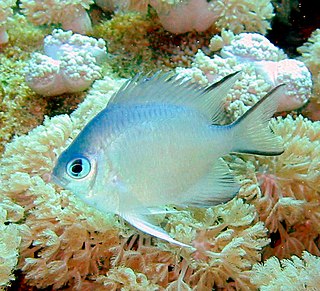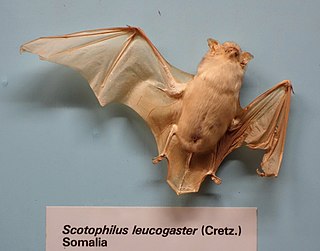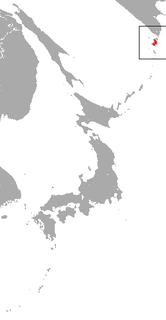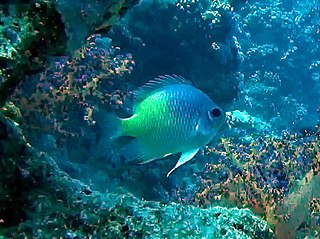
"Sardine" and "pilchard" are common names used to refer to various small, oily fish in the herring family Clupeidae. The term "sardine" was first used in English during the early 15th century and may come from the Mediterranean island of Sardinia, around which sardines were once abundant.

Amblyglyphidodon is a genus of fish in the family Pomacentridae. These damselfish swim singly, in pairs, or in small groups. They are often found among corals.

Perca fluviatilis, commonly known as the common perch, European perch, redfin perch, big-scaled redfin, English perch, Eurasian perch, Eurasian river perch or in Anglophone parts of Europe, simply the perch, is a predatory species of perch found in Europe and northern Asia. The species is a popular quarry for anglers, and has been widely introduced beyond its native area, into Australia, New Zealand, and South Africa. They have caused substantial damage to native fish populations in Australia and have been proclaimed a noxious species in New South Wales.

The brownspotted catshark is a rare catshark of the family Scyliorhinidae, found in the Indo-West Pacific between latitudes 11° N and 12° S. Its juvenile length is about 38 cm, but its adult size is mostly unknown. The reproduction of this catshark is oviparous.

The greater tube-nosed bat is a species of bat. An adult greater tube-nosed bat has a body length of 4.2-5.7 cm, a tail length of 3.6-4.1 cm, and a wing length of 3.7-4.4 cm. The species is found in India, Mongolia, China, and Korea.

Amblyglyphidodon indicus also known as the Maldives damselfish is a species of fish in the family Pomacentridae. It is native to the Indian Ocean, including the Red Sea and the Maldives. The fish reaches 8.3 centimeters in length. Its diet includes zooplankton and floating organic material. It is likely that this fish is reef-associated. It has been noted at depths up to 15 meters.

The white-bellied yellow bat is a species of vesper bat. It can be found in Angola, Benin, Botswana, Burkina Faso, Cameroon, Central African Republic, Chad, Ivory Coast, Gambia, Ghana, Guinea, Guinea-Bissau, Kenya, Mali, Mauritania, Namibia, Niger, Nigeria, Senegal, Sierra Leone, Sudan, Togo, Uganda, and Zambia. It is found in dry and moist savanna.
The white-bellied mosaic-tailed rat is a species of rodent in the family Muridae. It is found in West Papua, Indonesia and Papua New Guinea.

The Mediterranean, Southern or Miller's water shrew is a species of mammal in the family Soricidae.

The Paramushir shrew is a species of mammal in the family Soricidae. It is endemic to Russia. Its natural habitat is temperate forests. It is threatened by habitat loss.
Protemblemaria punctata, the Warthead blenny, is a species of chaenopsid blenny endemic to the Atlantic coast of northeast Venezuela where it is found on shallow, sandy bottoms down to a depth of 20 metres (66 ft). This fish can reach a maximum size of 6 centimetres (2.4 in) TL.
Microphis lineatus, the opossum pipefish, is a species of fish in the family Syngnathidae. It is found in fresh, brackish and marine waters in the West Atlantic region, ranging from New Jersey, United States, to São Paulo, Brazil, including the Caribbean and Gulf of Mexico. It is often found in rivers, among water hyacinth roots, in mangrove and in Sargassum.

Cephalopholis miniata, known commonly as the coral hind, is a species of marine fish in the family Serranidae. Other names include miniatus grouper, miniata grouper, coral or blue-spot rockcod, vermilion seabass, and coral grouper.

Bat Conservation International (BCI) is an international nongovernmental organization working to conserve the world's bats and their habitats through conservation, education, and research efforts.

Amblyglyphidodon aureus also known as the golden damselfish is a species of marine fish in the family Pomacentridae, the damselfishes and clownfishes. It is native to the central Indo-Pacific.
The Sarawak pygmy swellshark is a species of catshark, belonging to the family Scyliorhinidae. It is found in the benthic zone near the edge of the Pacific continental shelf, at depths of 118–165 m.

Amblyglyphidodon curacao; also known as the staghorn damselfish , the clouded damselfish or the bare-snouted sergeant major; is a species of marine fish in the family Pomacentridae, the damselfishes and the clownfishes. It's widespread throughout the tropical waters of the western Pacific Ocean. This species is a small sized fish that can reach a maximum size of 11 cm length.
The long-tailed Talaud mosaic-tailed rat or the long-tailed Talaud melomys is a species of rodent in the family Muridae. It is endemic to Karakelong and Salebabu in the Talaud Islands in Indonesia where it occurs in forest habitats. It is morphologically similar to the white-bellied mosaic-tailed rat and was at one time considered to be a subspecies but is now recognised as a distinct species. The short-tailed mosaic-tailed rat is also present on the islands and the shorter tail of that species means that it is likely to be mainly terrestrial whereas M. talaudium is largely arboreal.
The Seram long-tailed mosaic-tailed rat, also known as the Seram long-tailed melomys, is a species of rodent in the family Muridae. It is found only on the south coast of the island of Seram in Indonesia. At one time it was thought to be a subspecies of the white-bellied mosaic-tailed rat but was subsequently raised to full species level. It differs from that species in having a much longer, scale-free tail with a calloused tip which is likely to be prehensile and used while climbing trees.

Amblyglyphidodon flavilatus, known as yellow damselfish, yellowfin damselfish, yellow flank damselfish, yellow side damselfish, and yellow-sided Damselfish,is part of the family Pomacentridae, which is a family of ray-finned fish including damselfish and clownfish. This family represents the greatest diversity and abundance of fish species inhabiting coral reefs. They were first discovered in the 1980s by Allen and Randall.















